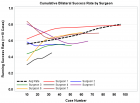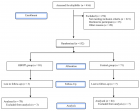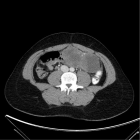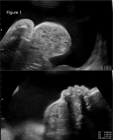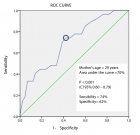About Fırat University
Fırat University
Articles by Fırat University
P wave dispersion in patients with premenstrual dysphoric disorder
Published on: 31st July, 2019
OCLC Number/Unique Identifier: 8192811430
Background: Growing evidence has revealed that fear and anxiety related situations could affect cardiac parameters. P wave dispersion (Pd) is an important index. In the present study, we aimed to evaluate Pd values in patients with premenstrual dysphoric disorder.
Methods: The study was composed of twenty-five female patients with premenstrual dysphoric disorder and same number of healthy controls. Pd, Pmin and Pmax values were determined by electrocardiogram (ECG) in the subjects.
Results: It was found that patients with premenstrual dysphoric disorder had considerably higher Pmax and Pmin values compared to those of healthy subjects. Pd was also significantly higher in patients with premenstrual dysphoric disorders than that of healthy subjects.
Conclusion: Study suggests that patients with premenstrual dysphoric disorder seems to have increased Pd, as can be seen in anxiety and fear related clinical conditions, considering that this group of patients have an increased trend to cardiac abnormalities, particularly cardiac arrythmias. To access strong conclusion, it is required novel studies with larger samples.
Dapt Review
Published on: 25th March, 2020
OCLC Number/Unique Identifier: 8576364795
Dual antiplatelet therapy (DAPT) combining aspirin and a P2Y12 receptor inhibitor has been consistently shown to reduce recurrent major adverse cardiovascular events (MACE) in patients with acute coronary syndrome (ACS) or undergoing percutaneous coronary intervention (PCI) for stable coronary artery disease (CAD) compared with aspirin monotherapy but at the expense of an increased risk of significant bleeding. Among patients with stable CAD undergoing PCI with drug-eluting stents (DES), shorter duration of DAPT (3–6 months) were shown non-inferior to 12 or 24 months duration concerning MACE but reduced the rates of major bleeding? Contrariwise, prolonged DAPT durations (18–48 months) reduced the incidence of myocardial infarction and stent thrombosis, but at the cost of an increased risk of majör bleeding and all-cause mortality. Until more evidence becomes available, the choice of optimal DAPT regimen and duration for patients with CAD requires a tailored approach based on the patient clinical presentation, baseline risk profile and management strategy. Patients with acute coronary syndromes (ACS) and a history of atrial fibrillation (AF) have indications for both dual antiplatelet therapy (DAPT) and oral anticoagulation (OAC). Triple therapy (TT), the combination of DAPT and OAC, is recommended in guidelines. This article provides a contemporary state-of-the-art review of the current evidence on DAPT for secondary prevention of patients with CAD and its future perspectives.
Circulating salusin-beta levels in the patients with age-related macular degeneration
Published on: 11th February, 2021
OCLC Number/Unique Identifier: 8918466046
Purpose: To evaluate the levels of salusin-beta (β-SAL) in the serum in patients with age-related macular degeneration (ARMD).
Methods: Our study was designed as a controlled comparative clinical study. The β-SAL levels in serums of age and sex-matched 20 healthy volunteers as controls (Group 1), 20 patients with dry-age related macular degeneration (d-ARMD) (Group 2) and 20 patients with wet-age related macular degeneration (w-ARMD) (Group 3) were measured with the enzyme-linked immunosorbent assay (ELISA) method.
Results: In our study, it was found that age and gender didn’t show a statistically significant difference among the study groups (p > 0. 05). The mean serum β-SAL levels in Group 1, Group 2 and Group 3 were 1372,17 ± 1126.69 pg/mL; 1423,71 ± 1196.84 pg/mL and 940,57 ± 1092.05 pg/mL, respectively. Although the meanβ-SAL levels in w-ARMD seem numerically lower than both the control and d-ARMD groups, this difference among the study groups was not statistically significant (p > 0.05).
Conclusion: Our study suggests that β-SAL levels in the patients with ARMD and healthy controls were not different than each other. Further studies with large numbers may reveal possible relationships between β-SAL and ARMD.
Successful treatment of late-onset pulmonary hypertension after atrial septal defect operation with macitentan: Our center experience
Published on: 17th August, 2018
OCLC Number/Unique Identifier: 7844628408
Background: Macitentan significantly improves pulmonary hemodynamics and survival in patients with primary pulmonary hypertension (PPH). Its beneficial effect, however, may be blunted due to the adverse impacts such as anemia and peripheral edema. Pulmonary arterial hypertension (PAH) is a significant consequence of congenital heart disease (CHD). Its presence and severity are associated with increased morbidity and mortality. We tried to evaluate that the effectiveness of the macitentan in patients with late-onset pulmonary hypertension after atrial septal defect operation in our center.
Methods: The effect of a single dose of macitentan (10 mg) on pulmonary hemodynamics, functional capacity was examined in four patients with late-onset pulmonary hypertension after atrial septal defect operation.
Results: The macitentan significantly improved mean pulmonary artery pressure (MPAP), cardiac output (CO), tricuspid annular plane systolic excursion (TAPSE), right ventricle systolic wave(RVS’), 6-minute walking test and NT-proBNP levels compared with before treatment.
Conclusions: Macitentan can be used in patients with late-onset pulmonary hypertension after shunt operation especially atrial septal defect.
Cranioplasty with preoperatively customized Polymethyl-methacrylate by using 3-Dimensional Printed Polyethylene Terephthalate Glycol Mold
Published on: 30th November, 2018
OCLC Number/Unique Identifier: 7935923400
Cranioplasty is a reconstructive procedure for the repair of skull defects or deformities. Polymethyl-methacrylate (PMMA) is a commonly used alloplastic material when autologous bone is unavailable. However, manual shaping of bone cement for frontal and orbital bone defects is challenging and may not lead to cosmetically satisfactory results. Advances in computer-aided 3-dimensional (3D) design and printing technology allow the production of patient-customized implants with improved cosmetic and functional results. A 39-year-old female patient presented with right-sided frontal swelling and headache. Computerized tomography (CT) demonstrated a right frontal calvarial mass extending to the orbital wall. The boundaries of the lesion were marked using a 3D design software. A polyethylene terephthalate glycol (PETG) mold was manufactured with help of a 3D printer. Artificial bone flap was formed by pouring PMMA into the mold. After surgical resection of the calvarial mass, customized PMMA implant was applied with titanium mini plate and screws. The defect was closed properly with good aesthetic results. Production of customized PMMA cranioplasty implants with 3D printed molds is a useful technique and can be preferred for calvarial defects due to skull tumors, bone resorption and traumatic bone loss.
Aflatoxin B1: Mechanism, oxidative stress, and effects on animal health
Published on: 18th May, 2022
Aflatoxins (AFs) are secondary fungal metabolites also known as mycotoxins which are produced by fungi of the Aspergillus genus, particularly Aspergillus flavus. The most common type of AF are AFB1, AFB2, AFG1, AFG1, AFM1 and AFM2. AFs are known to contaminate a large portion of the world’s food supply.AFB1 is the most carcinogenic of AF. AFB1 contamination of agricultural commodities poses a considerable risk to human and livestock health and high economic losses occur in the country crops and animals. Exposure of humans to AF leads to several health-related conditions including acute and chronic aflatoxicosis, immune suppression, liver cancer, liver cirrhosis, stunted growth, and many others. One of the causes of AFB1-induced toxicity is oxidative stress, which leads to the improved generation of reactive oxygen species (ROS) and oxidative DNA damage. These radicals initiate a damaging process in biological systems.This review focuses on the metabolic transformation of AFB1 and relates its mechanism of oxidative stress and its effects on animal health.

HSPI: We're glad you're here. Please click "create a new Query" if you are a new visitor to our website and need further information from us.
If you are already a member of our network and need to keep track of any developments regarding a question you have already submitted, click "take me to my Query."






